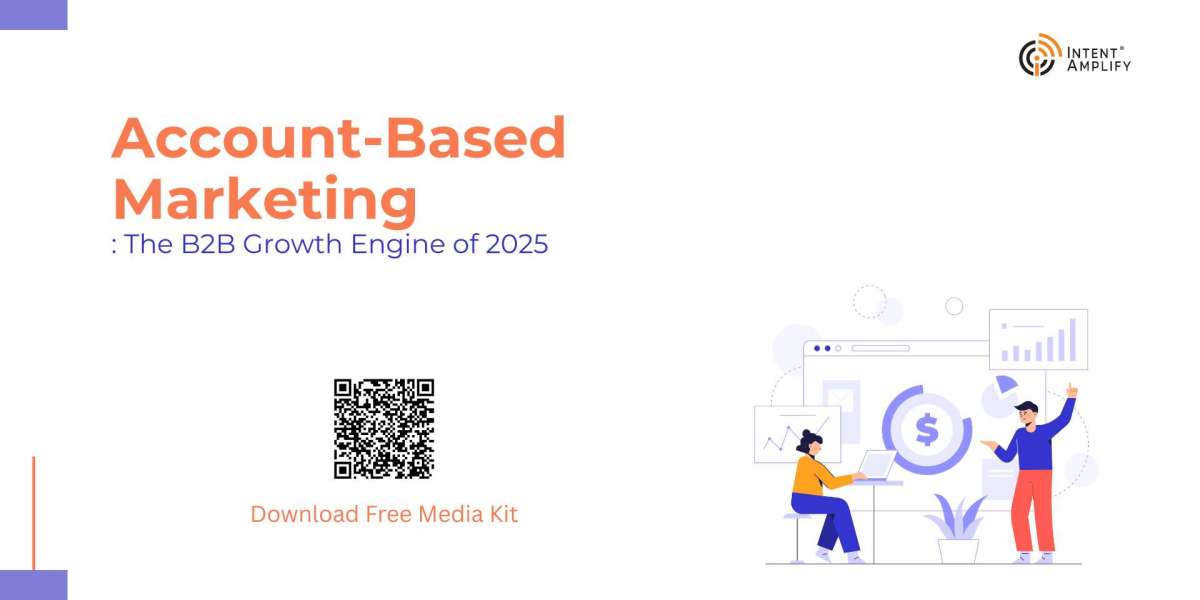Account-based marketing (ABM) continues to revolutionize how B2B companies approach sales and marketing alignment. Furthermore, businesses implementing strategic ABM tactics report significantly higher conversion rates compared to traditional marketing approaches.
At Intent Amplify®, we've helped countless organizations transform their B2B sales performance through proven account-based marketing strategies. Additionally, our data-driven approach ensures maximum ROI for every marketing dollar invested.
Why Account-Based Marketing Dominates B2B Sales in 2025
Recent industry studies reveal compelling statistics about ABM effectiveness:
According to Salesforce's 2024 State of Marketing report, 84% of B2B marketers now consider account-based marketing essential for their growth strategy. Moreover, companies using ABM report 73% higher conversion rates than those relying solely on traditional lead generation methods.
Similarly, businesses implementing comprehensive ABM strategies experience:
- 208% higher revenue growth compared to non-ABM approaches
- 36% better customer retention rates
- 50% larger deal sizes on average
These numbers demonstrate why forward-thinking companies prioritize account-based marketing tactics in their overall sales strategy.
Essential ABM Tactics That Transform B2B Sales Performance
1. Strategic Target Account Identification and Profiling
How do you identify the perfect accounts for your ABM campaigns?
The foundation of successful account-based marketing starts with precision targeting. Consequently, businesses must move beyond basic demographic data to understand behavioral patterns and buying signals.
Key Steps for Account Selection:
Start by analyzing your most profitable existing customers. Then, identify common characteristics such as company size, industry verticals, technology stack, and growth patterns. Next, use these insights to create detailed ideal customer profiles (ICPs).
Advanced Targeting Techniques:
Modern ABM requires sophisticated data analysis. Therefore, leverage technographic data to understand prospects' current technology investments. Additionally, examine firmographic information including revenue growth, employee count changes, and recent funding rounds.
What makes an account worth targeting?
Focus on organizations showing active buying signals through their digital behavior. For instance, companies researching solutions in your category, downloading relevant content, or attending industry events demonstrate higher conversion potential.
2. Hyper-Personalized Content Strategy Development
Why does personalization matter so much in ABM?
Generic content fails to resonate with decision-makers who receive hundreds of marketing messages daily. Instead, personalized content addresses specific business challenges and demonstrates clear understanding of each account's unique situation.
Content Personalization Framework:
Begin by mapping content to each stage of the buyer's journey for every target account. Subsequently, create account-specific assets that speak directly to their industry challenges, regulatory requirements, and competitive landscape.
Content Types That Drive Engagement:
- Custom case studies featuring similar companies in their industry
- Personalized video messages from C-level executives
- Interactive ROI calculators built for their specific use case
- Industry-specific whitepapers addressing regulatory changes
- Competitive analysis reports comparing solutions relevant to their evaluation
3. Multi-Channel Orchestration for Maximum Impact
How do you reach decision-makers across multiple touchpoints?
Successful ABM requires coordinated messaging across all channels where your prospects spend time. Therefore, develop integrated campaigns that deliver consistent value at every touchpoint.
Channel Integration Strategy:
Combine direct mail, email, social media, digital advertising, and sales outreach into cohesive campaigns. Furthermore, ensure messaging consistency while adapting format and tone for each specific channel.
Timing and Sequencing:
Orchestrate touchpoints strategically rather than bombarding prospects simultaneously. For example, start with educational content via LinkedIn, follow up with personalized emails, then deliver targeted ads reinforcing key messages.
4. Intent Data-Driven Prospect Identification
What is intent data and how does it improve ABM results?
Intent data reveals when prospects actively research solutions like yours, providing invaluable timing insights for sales engagement. Consequently, sales teams can prioritize accounts showing immediate buying interest.
Intent Data Applications:
Monitor keyword research patterns, content consumption behavior, and competitive intelligence gathering across your target account list. Additionally, track website visits, whitepaper downloads, and webinar attendance to identify warming prospects.
Behavioral Signal Recognition:
Look for sudden increases in solution-related research activity, multiple stakeholders from the same company engaging with content, and extended time spent on pricing or implementation pages.
5. Sales and Marketing Alignment Through ABM
How do you ensure seamless collaboration between teams?
ABM success depends on perfect alignment between sales and marketing teams. Therefore, establish shared goals, consistent messaging, and integrated processes from initial contact through deal closure.
Alignment Best Practices:
Create joint account plans detailing each team's responsibilities and success metrics. Moreover, implement regular review meetings to assess progress and adjust strategies based on account feedback.
Technology Integration:
Use CRM and marketing automation platforms that provide shared visibility into account engagement and pipeline progression. Additionally, ensure both teams access real-time data about prospect behavior and interaction history.
6. Account-Based Advertising for Targeted Reach
How does account-based advertising differ from traditional display ads?
Account-based advertising delivers personalized messages exclusively to decision-makers within your target accounts. Consequently, ad spend focuses on high-value prospects rather than broad audiences.
Platform Selection Strategy:
LinkedIn provides excellent targeting for B2B decision-makers, while programmatic platforms offer broader reach across the web. Furthermore, consider direct mail automation for high-touch engagement with executive-level prospects.
Creative Development:
Develop ad creatives that reference specific company challenges, industry trends, or competitive situations relevant to each target account. Additionally, test different messaging approaches to optimize engagement rates.
7. Executive Engagement and Relationship Building
Why should C-level executives participate in ABM campaigns?
Executive involvement demonstrates commitment and creates peer-to-peer connections that accelerate deal velocity. Moreover, C-suite engagement often differentiates your solution from competitors using standard sales approaches.
Executive Engagement Tactics:
Arrange executive briefings, industry roundtables, and exclusive events for target account leaders. Subsequently, maintain regular communication through thought leadership content and industry insights sharing.
Relationship Nurturing:
Focus on long-term relationship building rather than immediate sales conversion. Therefore, provide valuable industry insights, introduce strategic partners, and offer expertise that extends beyond your product capabilities.
Advanced ABM Measurement and Optimization
Key Performance Indicators for ABM Success
Which metrics truly matter for ABM program evaluation?
Move beyond traditional marketing metrics to focus on account-specific indicators that align with revenue generation goals.
Essential ABM Metrics:
- Account engagement score: Comprehensive view of all interactions across multiple touchpoints
- Pipeline velocity: Speed at which target accounts progress through sales stages
- Deal size growth: Average contract value increases from ABM-targeted accounts
- Customer lifetime value: Long-term revenue impact from acquired accounts
ROI Calculation and Program Optimization
How do you prove ABM program effectiveness?
Calculate ROI by comparing acquisition costs for ABM-targeted accounts versus traditional lead generation approaches. Additionally, factor in larger deal sizes and higher retention rates typical of ABM-acquired customers.
Continuous Improvement Process:
Regularly analyze campaign performance data to identify optimization opportunities. Furthermore, conduct win/loss interviews with both successful and unsuccessful target accounts to refine messaging and approach strategies.
Common ABM Implementation Challenges and Solutions
Challenge 1: Resource Allocation and Scaling
How do you balance personalization with operational efficiency?
Many organizations struggle with the resource intensity of highly personalized ABM campaigns. However, technology automation can maintain personalization while scaling program reach.
Solution Approach:
Implement marketing automation platforms that deliver personalized content at scale. Additionally, develop content templates that allow customization without requiring complete recreation for each account.
Challenge 2: Sales and Marketing Integration
What happens when teams remain siloed during ABM implementation?
Disconnected sales and marketing efforts result in inconsistent messaging and missed opportunities. Therefore, establish shared processes and communication channels from program launch.
Integration Strategy:
Create cross-functional ABM teams with representatives from both sales and marketing. Moreover, implement shared dashboards and regular alignment meetings to maintain coordination.
The Future of Account-Based Marketing
Emerging Trends and Technologies
How is artificial intelligence changing ABM approaches?
AI-powered tools increasingly help identify ideal accounts, predict buying behavior, and personalize content at unprecedented scale. Furthermore, machine learning algorithms optimize campaign performance in real-time.
Technology Integration:
Implement AI tools for lead scoring, content recommendation, and campaign optimization. Additionally, explore conversational AI for initial prospect engagement and qualification.
Predictive Analytics in ABM
Can you predict which accounts will convert before sales engagement?
Advanced analytics platforms analyze behavioral patterns, engagement history, and market signals to predict conversion probability. Consequently, sales teams can prioritize their time more effectively.
Getting Started with ABM at Your Organization
Implementation Timeline and Milestones
What does a realistic ABM implementation timeline look like?
Successful ABM programs typically require 3-6 months for initial setup and another 6-12 months to demonstrate full impact. However, some early indicators of success appear within the first few campaign cycles.
Phase 1: Target account identification and team alignment Phase 2: Content development and campaign creation
Phase 3: Campaign launch and optimization Phase 4: Scale and refinement based on performance data
Technology Stack Requirements
Which tools are essential for ABM success?
Modern ABM requires integration between CRM systems, marketing automation platforms, intent data providers, and analytics tools. Therefore, evaluate your current technology stack for gaps that might limit program effectiveness.
Essential Technology Components:
- CRM platform with account-based features and custom fields
- Marketing automation supporting account-based workflows
- Intent data platform for behavioral insights and timing
- Analytics dashboard providing account-level performance visibility
Conclusion: Transforming B2B Sales Through Strategic ABM
Account-based marketing represents the future of B2B sales and marketing alignment. Moreover, organizations implementing comprehensive ABM strategies consistently outperform competitors using traditional approaches.
The tactics outlined in this guide provide a roadmap for transforming your B2B sales performance through strategic account targeting, personalized engagement, and data-driven optimization.
Ready to implement world-class ABM strategies for your organization?
Intent Amplify® specializes in developing customized account-based marketing programs that drive measurable revenue growth. Our proven methodology has helped hundreds of B2B companies achieve 3X better conversion rates through strategic ABM implementation.
Download our comprehensive ABM Strategy Toolkit to access templates, checklists, and implementation guides that will accelerate your program launch. This free resource includes everything you need to build a successful ABM program from the ground up.
Additionally, schedule a free strategy consultation to discover how Intent Amplify® can customize an ABM program specifically for your industry and target market. Our team of ABM specialists will analyze your current approach and recommend optimization strategies for maximum impact.
Book Your Free ABM Strategy Session →
Intent Amplify® is a leading B2B marketing agency specializing in account-based marketing strategies that drive measurable revenue growth. Our data-driven approach and proven methodologies help companies achieve 3X better conversion rates through strategic ABM implementation.
Read Our Latest Blog
Measuring ABM ROI: Attribution Models Driven by Intent and Engagement Signals
What is The Psychology Behind B2B Buyer Decisions
How to Optimize Your Content for Google’s People Also Ask (PAA) Box
Contact Us:
1846 E Innovation Park Dr,
Suite 100, Oro Valley, AZ 85755
Phone: +1 (845) 347-8894, +91 77760 92666
Email: [email protected]



